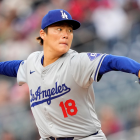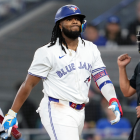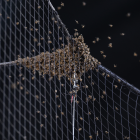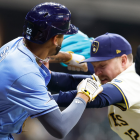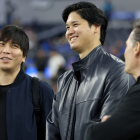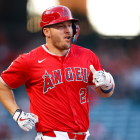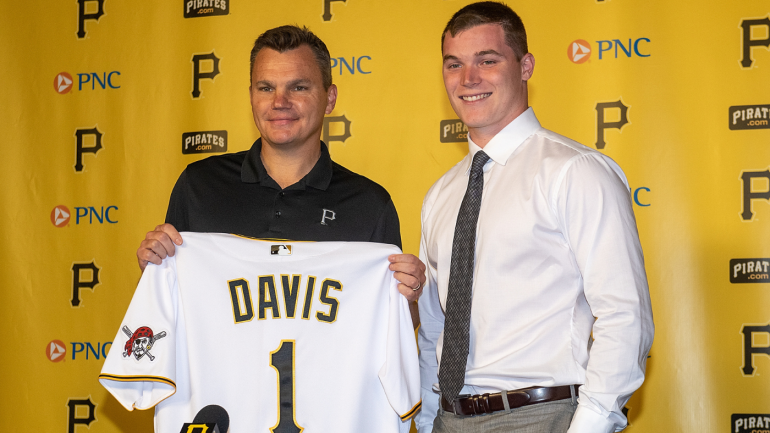
On Sunday, the Pittsburgh Pirates will make the No. 1 pick in Major League Baseball's amateur draft for the sixth time in their franchise history. The Pirates have previously selected Henry Davis (2021), Gerrit Cole (2011), Bryan Bullington (2002), Kris Benson (1996), and Jeff King (1986) with the top pick.
CBS Sports has spent the last several weeks previewing this year's class from a variety of angles, including ranking its top 30 prospects. Before the Pirates can turn in their selection on Sunday night, we felt it would be worthwhile to look at their recent draft history and their overall organizational situation heading into what could prove to be a pivotal three-day stretch for the franchise.
With that in mind, let's touch on three things worth knowing about the Pirates.
1. Poor recent draft history
As we noted in the introduction, the Pirates have held the No. 1 pick twice since 2010. We'll touch on the Davis selection in the next subheading, but the Cole choice is significant in its own right. That's because the Pirates have since whiffed time and again in the first round over the last dozen years.
From 2012-18 (we're using a five-year bumper here to provide players with ample time to reach the majors), the Pirates had 13 first or supplemental round selections. Three of those players did not sign. Of the 10 who did put pen to paper, only two have since accumulated as much as five Wins Above Replacement: Ke'Bryan Hayes and Austin Meadows -- and Meadows finished his Pirates career below the replacement-level threshold. What's more is that Hayes and Connor Joe -- who rejoined the organization last offseason -- are the only individuals from those 10 picks who are on Pittsburgh's active roster.
It's fair to write, then, that the draft was a struggle for the Pirates for a longer stretch than a franchise opposed to spending in free agency can withstand. The Pirates under owner Bob Nutting have and will continue to rely on cost-controlled players; the draft remains the best avenue to land those. An inability to nail first-round picks was a significant part of the reason the Pirates fired Neal Huntington and installed Ben Cherington in November 2019.
Here's a look at five of the Pirates' misses, as well as the most productive player drafted within the subsequent five picks:
| Year | Pick No. | Pirates pick | Optimal pick |
|---|---|---|---|
2018 | 10 | ||
2015 | 19 | ||
2014 | 24 | ||
2013 | 14 | ||
2012 | 45 |
It's almost like baseball's amateur draft is incredibly difficult in real time and incredibly easy with the benefit of hindsight. Who knew?
2. Cherington Era drafts starting to bear fruit
Cherington, for his part, has made five selections in the first and supplemental rounds since taking over the reins. Three of those five players were chosen using top-seven picks: the aforementioned Davis and infielders Nick Gonzales and Termarr Johnson. Cherington has also taken two collegiate right-handed pitchers in the top 40: Carmen Mlodzinski and Tom Harrington.
It's far too early to judge those picks on the basis of what they've done in the majors. Three of those individuals -- Davis, Gonzalez, and Mlodzinski -- have debuted in The Show this year, however, and they've each been productive in what amounts to extremely small samples.
Of those three, Davis has the best chance at becoming a mainstay thanks to his well-above-average raw strength. One question facing his future is where he'll play defensively. Though he was drafted as a catcher, the Pirates have played him in the outfield since promoting him to the majors. Rival front offices have speculated that the Pirates may find it difficult to return him to the squat if he shows offensive competency the rest of the way. (We'll add that the Pirates have another catching prospect, Endy Rodríguez, nearing the majors; scouts do not believe he has a bat suited for other positions the way that Davis does.)
Johnson elicited comparisons to Wander Franco and José Ramírez out of high school, with scouts fawning over his high-grade hit tool. His return to the Florida State League this year has him sporting a notably different profile that has him more geared to slug. His contact ability has dipped as a result. Johnson only recently turned 19, so it's to be seen if that ends up being a good trade-off; it's certainly not what anyone would have expected his game to look like just last summer. Harrington, meanwhile, has recorded nearly five strikeouts per walk in High-A, albeit while being too homer-prone.
3. Would they skip on Crews?
We mentioned in the first subheading that the Pirates must make the most of their draft picks, particularly the premium ones, given how reliant they are on manufacturing cost-controlled talent. So-so expectations for this season combined with the Nutting-imposed financial restraints on the front office saw them field an Opening Day payroll under $75 million this spring -- or, a figure that ranks in the bottom five for the sixth consecutive year.
In most cases, teams' financials are completely obscured. A suggestion that a team is capable of spending more is often met by some percentage of their fan base defending the owner's right to a profit (as if there aren't a multitude of easier and more effective ways for a billionaire to make a return on their investment in modern times). That's not the case with the Pirates. As Marc Normandin noted in 2022, there's reason to think they're able to cover their big-league payroll using only gate revenue. What happens to their revenue sharing funds and their (national and local) broadcast money? Only God knows, but it would be wise to have some skepticism about the whole thing.
With that in mind, it's reasonable to wonder if the Pirates are simply cheaping out if, come Sunday, they forego LSU outfielder Dylan Crews in favor of some other top prospect with a lower signing bonus demand. Remember, this is the same franchise who squandered three top-five selections over a four-year span from 2006-09 by selecting players with signing-bonus demands that ranked outside of the top five in their respective rounds.
| Year | Selection | Pick No. | $ Rank |
|---|---|---|---|
2006 | Brad Lincoln | 4 | 6 |
2007 | Daniel Moskos | 4 | 7 |
2009 | 4 | 9 |
The answer is "it depends."
In the Capped Bonus Era, sometimes it makes sense to save some coin upfront in order to snag better talent later on. The Pirates did just that in 2021, when they picked Davis No. 1 and went on to grab three other top-50 talents during the course of their draft. Most evaluators who have spoken to CBS Sports over the years have concluded that the portfolio approach is best deployed in drafts where there's minimal separation among the top players.
This year's draft is viewed as being a five-player class. There's Crews, Florida outfielder Wyatt Langford, LSU pitcher Paul Skenes, and prep outfielders Walker Jenkins and Max Clark. Crews is still viewed as the best prospect of the bunch (a veteran scout told CBS Sports in the spring that he was the most obvious No. 1 pick since Bryce Harper -- and nothing has changed since to alter that stance), but it's possible the Pirates think they can get more expected value from taking another, cheaper player at No. 1 to get better players later. That's a defensible position, even if it's a risky one from a public relations perspective if the strategy does not work out as the Pirates desired.
Of course, simply taking the best player at No. 1 and figuring out the rest of the class when it comes to that is also a defensible position. That's the beauty and the agony of picking No. 1: there's a whole big board of possibility out there to choose from. Some of it is good, some of it is bad, and you won't know for sure which is which until it's too late.
















